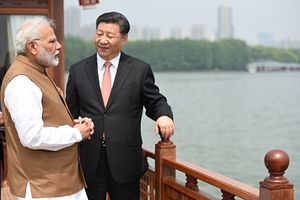It has been a year since India and China ended the 73-day border crisis in Doklam. And for all the focus on the crisis itself and its implications for Sino-Indian relations, it is worth recalling that along their border, Doklam is arguably an exception where the Indian military may be perceived to have a slight advantage over the Chinese military because of its slightly better infrastructure there.
Relatively speaking, however, the infrastructure on the rest of the border is quite appalling. Indeed, unless India accelerates the pace of the physical border infrastructure build-up, New Delhi will face serious difficulties in any future confrontation with China.
The Indian vice chief of army staff, in his statement to the Indian parliament’s Standing Committee on Defense, voiced serious concerns on the lack of adequate allocation of funds for the Army for 2018-19. He pointed to the “large number of Chinese strategic roads and infrastructural development along the northern borders” and made a case for bigger resource allocation, given that the sanctioned budget for infrastructure development was running massively short.
The current state of affairs with regard to the border infrastructure is the result of a flawed policy that was in place for several decades. The political, civil bureaucracy, and military leadership in India believed that building infrastructure in the Sino-Indian border area would actually compromise India’s security because it would facilitate any Chinese invasion.
In a testament to this line of thinking, the former defense minister, A.K. Antony, while addressing a function of the Border Roads Organization (BRO) in 2010, stated that “Earlier, the thinking was that inaccessibility in far-flung areas would be a deterrent to the enemies.” Acknowledging that this was an “incorrect approach,” he added that the government is now taking a number of measures to upgrade roads, tunnels, and airfields in the border areas.
Similarly, the BRO director general, Lt. Gen. A.K. Nanda, too went on record to say that the poor infrastructure in the border areas is by design but that “our approach has changed and we are building it on our capacity, modern equipment, and workforce.”
This policy underwent a change in 2006 with the Cabinet Committee on Security, a key policymaking body on national security issues within the government, taking a decision to develop 73 strategic roads along the LAC.
But more than a decade later, there is very little evidence to show on the ground. This is surprising considering that the BJP government has stressed infrastructure building, especially along the Sino-Indian border.
Minister of State for Home Affairs Kiren Rijiju stated in the Parliament earlier this year that infrastructure development along the border is “taken up based on threat perception, availability of resources and various other factors like terrain, altitude etc.” Speaking about the state of the Sino-Indian border areas, the director general of the Indo-Tibetan Border Police (ITBP), Krishna Chaudhary, said that 172 of the 176 new Border Out-Posts (BoPs) are now raised and that the work has picked up pace. He too acknowledged that India has been late in waking up to the border infrastructure requirement, but now “work has been ‘fast paced’ to build border roads in the states of Jammu and Kashmir, Himachal Pradesh, Uttarakhand, Sikkim and Arunachal Pradesh, that share their borders with China.”
Still, in the middle of the Doklam crisis, the minister of state for defense, Dr. Subhash Bhamre, while responding to a question in the Parliament, said that “73 Indo-China Border Roads along Northern Borders are approved for construction [back in 2006]. Out of this 27 roads have been completed and balance roads are planned for completion by December 2022.” The BRO, which is responsible for building strategic infrastructure in border areas, has missed several deadlines, raising questions about the BRO’s assurance about the 2022 deadline.
The minister went on to say that the delay in the construction of these projects is “due to delay in forest / wildlife / environment clearance, hard rock stretches, limited working season, delay in land acquisitions, difficulties in availability of construction material, and damage due to natural disasters such as flash flood.” Despite changes in governments, the excuses remain the same.
Reports suggest that incursions on the Sino-Indian may be coming down – there were reportedly about 500 transgressions in 2015, 350 in 2017, and around 200 up to July this year. Still, in addition to infrastructure problems, India also faces other difficulties For example, a multiplicity of agencies — the Army, the Indo-Tibetan Border Police (ITBP), the Border Security Force (BSF) and the Assam Rifles– managing the border on the Indian side is an issue. This means that both the Ministry of Home Affairs (MHA) and the Ministry of Defense have jurisdiction and India is not particularly known for good coordination between different departments and ministries.
On China’s side of the border, on the other hand, a single unified commander for the Tibetan Autonomous Region (TAR) forces is responsible for the border areas. It must also be noted that China has further strengthened the military command on the border by elevating the rank of the Military Command responsible for the border “by putting it under the jurisdiction of PLA ground forces.”
Though India’s infrastructure development is slow, this has not stopped Chinese media outlets such as Global Times from arguing that New Delhi is being provocative in building border posts and other infrastructure. But New Delhi has little choice but to continue pushing its border infrastructure, though there is little hope that it will very much faster.

































